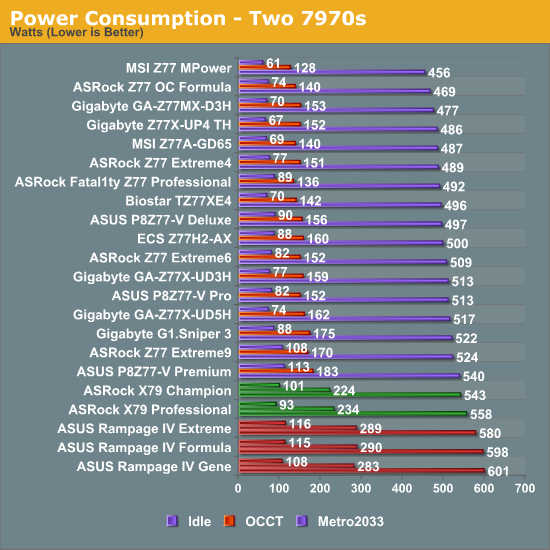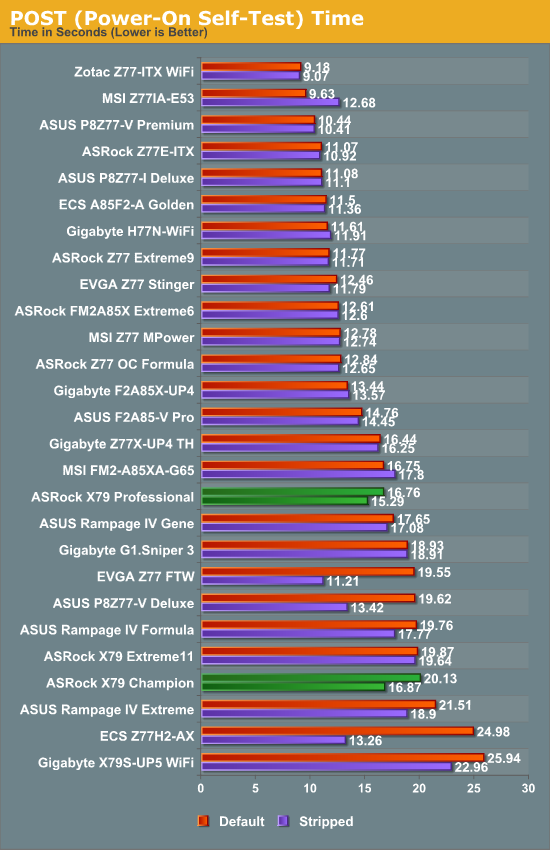ASRock Fatal1ty X79 Champion and X79 Professional Review: From a Gamer to Gamers
by Ian Cutress on February 9, 2013 10:30 AM EST- Posted in
- Motherboards
- ASRock
- Fatal1ty
- X79
Many thanks to...
We must thank the following companies for kindly providing hardware for our test bed:
Thank you to OCZ for providing us with the 1250W Gold Power Supply and USB testing SSD.
Thank you to Micron for providing us with the SATA testing SSD.
Thank you to G.Skill for providing us with the memory kits.
Thank you to ASUS for providing us with the AMD GPUs and some IO Testing kit.
Thank you to ECS for providing us with the NVIDIA GPUs.
Additionally, many thanks to Corsair for providing us with the Corsair H80i CLC, as this is the first time we are using this unit in motherboard testing. The H80i is the Corsair Link enabled and updated version of the H80, the closed-loop liquid cooling system with a 120mm double width radiator. Dustin reviewed the unit at the beginning of the year, and is currently available for $95.
Test Setup
| Test Setup | |
| Processor |
Intel Core i7-3960X 6 Cores, 12 Threads, 3.3 GHz (3.9 GHz Turbo) |
| Motherboards |
ASRock X79 Professional ASRock X79 Champion |
| Cooling | Corsair H80i CLC |
| Power Supply | OCZ 1250W Gold ZX Series |
| Memory | GSkill RipjawsZ 4x4 GB DDR3-2400 10-12-12 |
| Memory Settings | 2133 10-12-12 |
| Video Cards |
ASUS HD7970 3GB ECS GTX 580 1536MB |
| Video Drivers |
Catalyst 12.3 NVIDIA Drivers 296.10 WHQL |
| Hard Drive | Micron RealSSD C300 256GB |
| Optical Drive | LG GH22NS50 |
| Case | Open Test Bed - CoolerMaster Lab V1.0 |
| Operating System | Windows 7 64-bit |
| SATA Testing | Micron RealSSD C300 256GB |
| USB 2/3 Testing | OCZ Vertex 3 240GB with SATA->USB Adaptor |
Power Consumption
Power consumption was tested on the system as a whole with a wall meter connected to the OCZ 1250W power supply, while in a dual 7970 GPU configuration. This power supply is Gold rated, and as I am in the UK on a 230-240 V supply, leads to ~75% efficiency > 50W, and 90%+ efficiency at 250W, which is suitable for both idle and multi-GPU loading. This method of power reading allows us to compare the power management of the UEFI and the board to supply components with power under load, and includes typical PSU losses due to efficiency. These are the real world values that consumers may expect from a typical system (minus the monitor) using this motherboard.
While this method for power measurement may not be ideal, and you feel these numbers are not representative due to the high wattage power supply being used (we use the same PSU to remain consistent over a series of reviews, and the fact that some boards on our test bed get tested with three or four high powered GPUs), the important point to take away is the relationship between the numbers. These boards are all under the same conditions, and thus the differences between them should be easy to spot.

Power consumption on the ASRock boards is much lower than that of the ASUS Rampage boards, especially during OCCT loading.
Windows 7 POST Time
Different motherboards have different POST sequences before an operating system is initialized. A lot of this is dependent on the board itself, and POST boot time is determined by the controllers on board (and the sequence of how those extras are organized). As part of our testing, we look at the POST Boot Time - this is the time from pressing the ON button on the computer to when Windows starts loading. (We discount Windows loading as it is highly variable given Windows specific features.) Despite the advent of Windows 8 introducing features for quick booting within several seconds, a significant number of users are still on Windows 7, where POST times usually fall in the 7-25 second range. For a good result, we are looking for around 12 seconds when the board has two GPUs fitted (one for mITX), as per our testing. We test both the stock boot time (with BIOS at default), and a stripped BIOS where all extra onboard controllers (LAN, USB 3.0, SATA, etc.) are disabled.

Unfortunately the Champion falls down on boot times, hitting over 20 seconds at default but saving a little grace with 16.87 seconds when stripped. The Professional has a better time, beating the stripped Champion while at stock, and going a little further when stripped. Neither however have great boot times.











71 Comments
View All Comments
scaramoosh - Saturday, February 9, 2013 - link
I don't get why they release these, he's done nothing in half a decade and no self respecting person who knows anything about hardware would buy because of a so called Celeb name being put on it. It just acts as a warning sign for me...Tech-Curious - Saturday, February 9, 2013 - link
I admit that I didn't really know who Fatal1ty was before I read this article, apart from a vague recognition that the silly leet-speak moniker belonged to someone in gaming.And I agree with your general point, that such branding on a motherboard is silly.
But all of that said, if the guy really did win $500,000 in gaming competitions, that's a pretty big deal. Now that he's retired, if companies (or, perhaps, their customers) are dumb enough to give him a comfortable living through lame marketing campaigns like ASRock's, then more power to him.
Wouldn't touch the motherboard with a ten foot pole, but I can't blame the endorser for accepting the check.
Nice review.
Beenthere - Saturday, February 9, 2013 - link
The "Fatality" branded mobos are just Asrocks high end models. They are pretty good mobos.The issue is the marketing is dumb as are those who buy products based on this type of marketing. Clearly enough Asrock customers voiced their displeasure with the crap marketing of John Boy all over the place as Asrock removed his image from the BIOS and allows people to disable his face on the boot screen too. Owner reviews in any PC hardware forum show a lot of folks unhappy with the marketing - not the mobos.
Samus - Saturday, February 9, 2013 - link
I've owned a few Fatal1ty products and all of them have been really good quality, especially the headsets and mice.I don't think the guy will put his name on crap. And I don't think companies making crap want his name on their product, since it isn't cheap to put his name on that product and if it backfires, it'll cost them.
Omega215D - Sunday, February 10, 2013 - link
The Creative gaming mice with his name on it weren't all that great performance-wise and were pretty much crap compared to stuff from Logitech in those days. The sound cards weren't anything special as well but cost much more than it should.hp79 - Sunday, February 10, 2013 - link
I had a crap fatality branded geforce 8800gs or something, and it was uber crap. I got this as a repalcement when my 7900gs died. My 8800gs had no fan control, so it was running at 100% all the time. Very loud graphics card. I sold it after couple days.I really don't see a point branding it with a person maybe because I don't even know or care who this dude is.
StevoLincolnite - Sunday, February 10, 2013 - link
I had a Fatal1ty 990FX board in my old AMD rig, was incredibly solid and overclocked like a champ.Unfortunately, I needed more performance and decided to go with a Military themed build so went with the Asus Sabertooth X79 board, which other than slightly noisy motherboard fans is solid too.
aguilpa1 - Tuesday, February 12, 2013 - link
Yea, I still have a Fatal1ty Xfi audio card but I didn't buy because it had his handle on it but because at the time it was the only Xfi model that offered the break out box front panel.JonnyDough - Friday, February 15, 2013 - link
It tells us that it's a high-end board though. Just as it did for Creative and whoever else. It's like putting Ferrari on a monitor....LOLFlunk - Saturday, February 9, 2013 - link
I agree. I refuse to buy anything branded with that name on principle. I'm not paying extra just for branding from someone I don't even respect or care about. Hell, I would rather have a Michael Jordan* branded motherboard than a one of these.*No, I do not like Basketball.